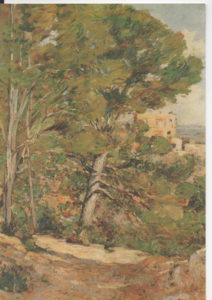R937 – Chateau Noir, 1900-1904 (FWN359)
Pavel Machotka
(Cliquer sur les images pour les agrandir)
The site of the R937–FWN359 painting is once again Château Noir building seen through trees, but in this view of it there is none of the ordered lyricism of Château Noir derrière les arbres. Here, a subject that generally inspires a well constructed canvas has evoked a harsh, dissonant, even violent response. We will never know whether the picture’s vehemence represents a threatening moment such as a storm, or an inner state of the artist, or yet some conscious intention. We can presume that an actual branch intruded into the scene from the right—it looks like the dead limb of an umbrella pine—but that would not explain the jagged, repetitive, and heavily built up touches with which he painted it, nor the thickened, incised branches on the left, nor the confusion of the patches representing the vegetation. Perhaps most arresting is the upper right corner, with its cacophony of patches which, uncharacteristically, lie neither in front of one another nor in the same plane, signifying nothing other than darkening the sky. It seems an angry or frightened picture—but it is also fully finished, heavily built up, and perfectly consistent in its style. If it was inspired by an event or a mood, it came to represent it with deliberation; and in its purposive way it resembles the only other vehement painting in Cézanne’s late work that I can think of, a still life: the roughly contemporary Nature morte, rideau à fleurs et fruits (R935-FWN885).
Source: Machotka, Cézanne: The Eye and the Mind
Joseph RAVAISOU, ami et ardent défenseur de Cezanne, a peint Château Noir apparemment depuis le même endroit que lui (cf ressemblance des arbres à gauche) :




